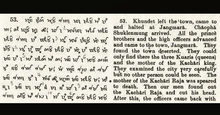Buranji
Buranjis (Ahom language:ancient writings)[1] are a class of historical chronicles and manuscripts written initially in Ahom Language[2] and afterwards in Assamese language.[3] The first such Buranji was written on the instructions of the first Ahom king Sukaphaa who established the Ahom kingdom in 1228.

History
There were two kinds of Buranjis: one maintained by the state (official) and the other maintained by families.[4] Many such manuscripts were written by scribes under the office of the Likhakar Barua, which were based on state papers, diplomatic correspondences, judicial proceedings, etc. Others were written by nobles or by people under their supervision, sometimes anonymously. These documents reveal chronology of events, language, culture, society and the inner workings of the state machinery of the kingdom. They were written in "simple, lucid and unambiguous but expressive language with utmost brevity and least exaggeration." The tradition of writing Buranjis survived more than six hundred years well into the British period, till a few decades after the demise of the Ahom kingdom.[5]
The Buranjis not only describe the Ahom kingdom, but also the neighbours (Chutiya, Kachari and Tripura Buranjis) and those with whom the Ahom kingdom had diplomatic and military contacts (Padshah Buranji). They were written on the barks of the Sanchi tree or aloe wood. Though many such Buranjis have been collected, compiled and published, an unknown number of Buranjis are still in private hands. During the reign of Rajeswar Singha, Kirti Chandra Borbarua had many Buranjis destroyed because he suspected they contained information on his lowly birth.[6]
Controversies
Ahom local historians claim 18th century buranjis to be 13th century.[7]
Language
Most of the manuscripts Buranjis are written in Ahom language. But later the tradition of writing Buranji was minimised and amount of Buranji become lesser and Assamese Lingua franca adopted by the end of the kingdom. Western Assamese was the dominant literary language and the "sole medium of all ancient Asamiya literature including the Burañjīs written in the Ahom courts". The Eastern Assamese dialect became the standard literary language of the region in around the early-19th century.[8] Gargaya, a style of Assamese writing that developed between the 17th and 19th centuries, was notably used in eastern Assam for writing Buranjis.[9]
Modern Buranjis
Some authors published Modern Books with the domain of Buranji which does not chronicle Buranji Manuscripts but they are based on the manuscripts. Those books are known as Modern Buranji. Some of the examples of most popular Modern Buranjis are -
| No. | Name | Author |
| 1 | Assam Buranji | Harakanta Baruah |
| 2 | Assam Buranji | Kasinath Tamuli Phukan |
| 3 | Ahom Buranji | Golap Chandra Barua |
| 4 | Purani Assam Buranji | Hemchandra Goswami |
| 5 | Tungkhungia Buranji | Surya Kumar Bhuyan |
| 6 | Tripura Buranji | Ratna Kandali and Arjun Das, 1724 |
| 7 | Sokori feti Buranji | Nagen Hazarika,1990 |
| 8 | AburanjiK | Nagen Hazarika, |
| 9 | Ajagar Buranji | Nagen Hazarika,1996 |
| 10 | Mati Feti Buranji | Nagen Hazarika |
| 11 | The Buranjis, Historical Literature of Assam: A Critical Survey | Lila Gogoi |
| 12 | Tungkhungia buranji | Srinath Duara Barbarua |
| 13 | Jiban buranji | Nagen Hazarika,1990 |
| 14 | Kal feti buranji | Nagen Hazarika,1993 |
| 15 | Ahom Sabhar Khusura buranji | Nagen Hazarika,1994 |
| 16 | Ahomar Hangskriti buranji | Nagen Hazarika,1996 |
| 17 | Makarajal buranji | Nagen Hazarika,1996 |
| 18 | Karshala aru kathi seleka buranji | Nagen Hazarika,1999 |
| 19 | Bibhinna Dharmar buranji | Nagen Hazarika,2002 |
| 20 | Tae Tae buranji | Nagen Hazarika,2003 |
| 21 | Naganya buranji | Nagen Hazarika,2008 |
Notes
- Hartman 2011, p. 227: "The Tai-Ahom term buran is cognate with the Standard Thai word boran (ancient). Buranji, then, are ancient writings."
- (Barua 1953:132)
- Goswami 2007, p. 436.
- Hartmann 2011, p. 228.
- (Saikia 2008:479)
- Sarkar, J. N. (1992) The Buranjis: Ahom and Assamese in The Comprehensive History of Assam Vol II (ed H K Barpujari), Publication Board, Assam
- Saikia 2004, p. 113.
- Goswami & Tamuli 2007, p. 436.
- Saikia 2004, p. 6.
References
- Barua, B K (1953). "Early Assamese Prose". In Kakati, Banikanta (ed.). Aspects of Early Assamese Literature. Guwahati: Gauhati University, Assam. pp. 124–147. Retrieved 12 February 2018.CS1 maint: ref=harv (link)
- Goswami, G. C.; Tamuli, Jyotiprakash (2007), "Asamiya", in Cordona, George; Jain, Dhanesh (eds.), The Indo-Aryan Languages, Routledge, pp. 429–484CS1 maint: ref=harv (link)
- Saikia, Yasmin (2004). Fragmented Memories: Struggling to be Tai-Ahom in India. Duke University Press. ISBN 082238616X.CS1 maint: ref=harv (link)
- Hartmann, John F. (7 April 2011). "Phongsawadan Tai-Ahom: Ahom Buranji [Tai-Ahom Chronicles], 2 Vols. Transcribed and translated by Renu Wichasin. Bangkok: Amarin Printing and Publishing Ltd. Pp. xxiv, 993 [Continuous Pagination]. Map, Photos, Tables, Glossary. [In Thai]". Journal of Southeast Asian Studies. 28 (01): 227–229. doi:10.1017/S002246340001554X.CS1 maint: ref=harv (link)
- Saikia, Arupjyoti (2008). "History, buranjis and nation: Suryya Kumar Bhuyan's histories in twentieth-century Assam". The Indian Economic and Social History Review. 45 (4): 473–507. doi:10.1177/001946460804500401.CS1 maint: ref=harv (link)
- Sarkar, J. N. (1992) The Buranjis: Ahom and Assamese in The Comprehensive History of Assam Vol II (ed H K Barpujari), Publication Board, Assam